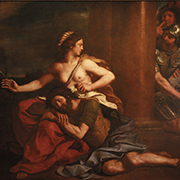“Samson et Dalila” is the only stage work by the French composer Camille Saint-Saëns which has an established place in the repertoire. Now it’s being published in a historical-critical edition for the first time.
Camille Saint-Saëns composed works in all genres. Above all, he wanted to succeed as an opera composer, as reflected in the thirteen stage works he wrote. But it’s only Samson et Dalila which is still in the repertoire nowadays. The composer was fully conscious of the unusual angle of this opera, with its Biblical, military and erotic themes encompassed within a single musical work, compared with other opera plots of the time. At the same time these special features were also the reasons which worked against acceptance of the opera in France for a long time: it was criticized for being too close to the form of oratorio and for its Wagnerian character. And that is why the premiere in 1877 took place not in France, but, after many years of work on the part of his friend and patron Franz Liszt, at the Großherzogliches Hoftheater in Weimar.
Of course the ambitious composer’s aim was to have his opera performed at the leading venue in France, by the Paris Opéra which had its home at the Palais Garnier. However, Saint-Saëns only achieved this after numerous intermediate locations, the most important of which were the French concert premiere in Brussels in 1878, the first production on French soil in Rouen in 1890 and a production following on from that in the Eden-Théâtre in Paris in the same year. And before the much-anticipated definitive performance finally took place in November 1892, Samson et Dalila had already enjoyed a truly successful international run, with performances in Geneva, Barcelona, Algiers and Milan.
During this period, the musical form of the work did not change very much. Between making the fair copy to the publication of the full score in its last version, Saint- Saëns altered very few passages: between the Weimar first version and the original version of the autograph fair copy which functioned as the main source, alterations were made to the orchestration of the wind instruments (Acte I, Scène 2, bars 215–229), the insertion of a 31-bar transition in the third act (between the first and second tableaux), and an additional ballet number before the “Danse”, which also survives separately as “Bacchanale” – the 57 bar-long “Réveil des Prêtresses”. A brief note in the autograph fair copy reveals that they were composed later for the premiere at the Paris Opera in 1892. (The Critical Commentary in the new edition in the L’Opéra français series contains information on all the different variant readings.) One possible answer to the question about why the ballet numbers composed specially for Paris were later abandoned can be found in the conductor’s score, which was used for many years in the Paris Opéra. There the ballet numbers were variously reworked, finally emerging without the “Réveil des Prêtresses” and, moreover, a possible cut was marked in the Bacchanale – it was therefore intended to perform the third act entirely without ballets, even cutting the effective “Bacchanale”, which had been issued by the original publisher Durand as a separate number. We can probably assume that performance traditions had changed in the meantime: it’s almost possible to talk of a belated victory for Wagnerianism, if the ballet numbers, or sequences of numbers, once regarded as quintessentially characteristic of French opera, fell victim to later cuts.
The new edition makes it possible to both perform and study Samson et Dalila for the first time with material which reflects modern conventions, but also to gain new insights into the history of the work from this new critical edition of the music and libretto (the latter prepared by Fabien Guilloux, taking into consideration the version of the German premiere by Richard Pohl).
Andreas Jacob
(from: [t]akte 2 / 2015)



